Heinrich Schmutzenhofer
(Youqing Luo)
(Junbao Wen)
This manual is designed to provide information and assistance to poplar growers and foresters in their daily management of forest nurseries and plantations. The information compiled in this manual is derived from several sources viz, the field reports of previous consultants to the project (GCP/CPR/009/BEL), especially the work of Mr. G. Arru. local professionals of the project, and investigations by the authors during their term of consultancy in August and September 1994.
There is a List of Forest Insects Found in the Project Area and additional records of forest insects in Chinese forests, available for reference from various Chinese entomological literature. The area covers Korqin and extends into the adjacent county of Jin-Xian. Liaoning Province, all in the northeast portion of the Three North Region Afforestation Project. The records refer in detail to all four forest Branches: Jin-Xian and Zhang-Wu in Liaoning Province. Naiman and Tongliao in the Autonomous Region of Inner Mongolia, and Tong-Yu and Baicheng in Jilin Province. The records represent a forest plantation area of more than 15×104 hm2 but cannot be considered as complete at this stage.
Under consideration are insect pests that can cause damaging effects on forests and forest plantations. Insect attacks can cause increment reduction, severe economic losses, lowering of quality and the decline or death of trees. Forest practitioners should study and be familiar with local pests and should obtain assistance in identifying insects as well as evaluate their impacts on the management of forest plantations. Control strategies are changing steadily and economic and environmental concerns are becoming increasingly important. Threshold levels of injury and economic decisions have to be established and applied in practice under integrated pest management systems.
The biological data on important insects, the characteristics of insects and damage inflicted by them, and the background for insect pest control methods as outlined in this manual should provide tools for future forest management strategies to improve forest cover in the region. In case of doubt on the evaluation of insect pests, forest practitioners should seek assistance from FAO or from the national forest protection organizations.
This list, based on insects found in the project area, has been updated and amended to correspond to records from existing entomological literature. Those insects, not comprehensively described in the manual, are characterised briefly here, to provide the user of the manual with sufficient information to at least facilitate the evaluation of their effects on the forests.
1.1 INSECT PESTS ON POPLARS
1.1.1 BORING INSECTS
Yang Gan Xiang, Cryptorrhynchus lapathi Linnaeus. (Coleoptera: Curculionidae). Osier weevil
Guang Jian Xing Tian Niu, Anoplophora glabripennis (Motsch.). (Coleoptera: Cerambycidae). Smooth shoulder-star longicorn, beetle. Also on maple, willow and elm.
Qing Yang Tian Niu, Saperda populnea Linnaeus. (Coleoptera: Cerambycidae). Small poplar borer, longicorn beetles.
Bai Yang Tou Chi E, Paranthrene tabaniformis Rottenberg. (Lepidoptera: Sessiidae). Dusky clear-wing moth.
Yu Mi Ming, Pyrausta nubilalis (Hubner), (Lepidoptera: Pyralidae). Corn borer. Important stem borer in maize, but has adapted to poplars. Damage is similar to that caused by the dusky clear-wing moth but larvae differ due to their coronated legs.
Liu Bian E, Phassus excrescens Butler, (Lepidoptera: Hepialidae). Ghost or swift moth. Appears like the corn borer and sometimes mistaken for the dusky clear-wing moth.
Fang Xiang Mu Du E Dong Fang Ya Zhong, Cossus cossus orientalis Gaede, (Lepidoptera: Cossidae). Goat moth, carpenter worm, timber moths. Large moth with wing span up to 12 cm, and larva measuring up to 10 cm, pink-red, with vinegar-like smell. Bores into many tree species like willow, elm, maple and fruit trees.
Yang Jin Wen Jie Wei Ji Ding, Poecilonota variolosa (Paykull). (Coleoptera: Buprestidae), buprestids. Beetle reported from Jilin province. Exit-hole, like in all buprestids, is cross-oval with an uneven, bent outline.
Qing Yang Ji Hu Tian Niu, Xylotrechus rusticus Linnaeus. (Coleoptera: Cerambycidae). Tiger longicorn beetle. A small and quick-moving beetle of minor importance.
1.1.2 ROOT FEEDERS
Da Yun Ban Sai Jin Gui, Polyphylla laticollis Lewis. Coleoptera: Scarabaeidae). Cockchafer grub. The adult (beetle) is a leaf feeder and sometimes defoliates.
Hei Rong Sai Jin Gui, Maladera orientalis Mutschulsky. (Coleoptera: Scarabaeidae). Black velvety chafer. The adult, a bud feeder, is more injurious than the larvae causing root damage.
Da Hui Xiang, Sympiezomias velatus (Chevrolat), (Coleoptera: Curculionidae). Big gourd-shaped weevil.
Hua Bei Lou Gu, Gryllotal pa unispina Saussure. (Orthoptera: Gryllotalpidae). Giant mole cricket, mongolian mole cricket. Injurious to seedlings in forest nurseries.
Dong Fang Lou Gu, Gryllotal pa orientalis Burmeister. (Orthoptera: Gryllotalpidae). Oriental mole cricket.
1.1.3 LEAF FEEDERS AND DEFOLIATIORS
Yang Shan Zhou E, Clostera (Pygaera) anachoreta (Fabricius). (Lepidoptera: Notodontidae). Reddish-tipped prominent moth.
Fen Yue Shan Zhou E, Clostera (Pygaera) anastomosis (Linnaeus). (Lepidoptera: Notodontidae). Black-back prominent moth.
Huang Ci E, Cnidocampa flavescens (Walker). (Lepidoptera: Notodontidae). Brown slug moth.
Yang Er Wei Zhou E, Cerura (Dieranura) menciana Moore. (Lepidoptera: Notodontidae). Large grained moth. The big and thick, green caterpillar with a velvety red mark stretching over the back and an elongated forked tail, feeds freely and gregariously on poplar and willow leaves. Occasional defoliator.
Wu Du E, Lymantria dispar Linnaeus. (Lepidoptera: Lymantriidae). Gipsy moth.
Yang Du E, Stilpnotia (Leucoma) candida Staudinger. (Lepidoptera: Lymantriidae). Willow moth. Moth looks like satin moth, one generation per year. Third instar larva overwinters in leaves on soil surface.
Liu Du E, Stilpnotia (Leucoma) salicis (Linnaeus). (Lepidoptera: Lymantriidae). Satin moth.
Gu Du E, Orgyia antiqua (Linnaeus). (Lepidoptera: Lymantriidae). Rusty tussock moth. Polyphagous caterpillar with colourful hair-brushes on head, body and tail. Two generations a year. Female moth has no developed wings.
Huang He Tian Mu Mao Chong, Malacosoma neustria testacea Mutschulky. (Lepidoptera: Lasiocampidae). Common lackey moth, tent moths. Eggs in spirals around twigs. Larvae, blue-headed, with white and blue stripes along back and sides, thrive on many tree species and make tent-like structure on branches and defoliate.
Mei Guo Bai E, Hyphantria cunea (Dray). (Lepidoptera: Aretiidae). Fall webworm. Moth is white, like satin moth, and is a pest introduced from North America. Wings of male adults of overwintering generation with brown-black spots. The second-third instar young caterpillars skeletonize leaves and live together in a dense web. Old larvae feed gregariously on leaves.
Lan Mu Tian E, Smerinthus planus planus Walker. (Lepidoptera: Sphingidae). Cherry-horn worm. Big, thick, grass-green caterpillar. Pronounced horn at back tail. Attractive.
Chun Chi Huo, Apochemia cinerarius Erschoff. (Lepidoptera: Geometridae). Mulberry geometrid, mulberry looper.
Yang Bai Qian E, Leucoptera susinella Herrich-schaffer. (Lepidoptera: Lyonetiidae). Blotch leaf miner.
Yang Hei Dian Ye Feng, Pristiphora conjugata (Dahlbom). (Hymenoptera: Tenthredinidae). Poplar sawfly.
Yang Chui Jiao Ye Feng, Cimbex taukushi Marlatt, (Hymenoptera: Tenthredinidae). Sawfly.
Yang Qian Ye Ye Feng, Messa taianensis Xiao et Zhou. (Hymenoptera: Tenthredinidae). Sawfly. 1 generation per year, prepupa overwinter in soil.
Liu Lan Ye Jia, Plagiodera versicolor (Laicharting). (Coleoptera: Chrysomelidae). Imported. Willow leaf beetle. Oval, metallic greenish-blue beetle. Severe damage in nurseries is possible. Three generations per year, beetles overwinter.
1.1.4 SUCKING INSECTS
Liu Li Dun Jie, Lepidosaphes salicina Borchs, (Coccoidea: Diaspididae). Willow scale species. Can cause branch dieback on trees.
Yang Yuan Jie, Quadraspidiotus gigas (Thiem et Gerneck), (Coccoidea: Diaspididae). Giant scale. Round scale on stem and branches may cause its death. Damage also to willows.
1.1.5 MISCELLANEOUS INSECTS
Da Qing Ye Chan, Cicadella (Tettigoniella) viridis (Linnaeus), (Homoptera: Cicadellidae). Green leaf hopper.
1.2 INSECTS ON PINES
1.2.1 NEEDLE FEEDERS AND DEFOLIATORS.
Luo Ye Song Mao Chong, Dendrolimus superans Butler. (Lepidoptera: Lasiocampidae). Siberian spinning moth, larch caterpillar.
You Song Mao Chong, Dendrolimus tabulaeformis Tsai et Liu. (Lepidoptera: Lasio-campidae). Chinese-pine caterpillar. Very similar to the larch caterpillar, moth more distinct.
1.2.2 BORING INSECTS
Song Shao Ming, Dioryctria sp. (Lepidoptera: Pyralidae). Pine shoot borer. Enters via lateral buds into the terminal shoot and tunnels down.
1.3 INSECTS ON ELMS
1.3.1 LEAF FEEDERS AND DEFOLIATORS
Yu Zi Ye Jia, Ambrostoma quadriimpressum Motschulky. (Coleoptera: Chrysomelidae). Beetle, 1cm long has dark green metallic with bronze-reddish longitudinal stripes on the back (elytrae). 1 generations per year, beetle overwinters in soil.
Yu Lan Ye Jia, Pyrrhalta aenescens Fairmaire. (Coleoptera: Chrysomelidae). Beetle, 7–8mm long, oblong-shaped with brown with metallic-green elytra. 2 or 3 generations, beetle overwinters in soil and crevices.
Yu Huang Zu Du E, Ivela ochropoda (Eversmann). (Lepidoptera: Lymantriidae). Yellow-legged tussock moth. 15mm, terminal parts of legs are yellow. Two generations per year
The biodata (table 1) compiled here are based on local observations by forest farm technicians, local forest entomologists and of Chinese forest entomology literature. Highly appreciated were the information received from Mr. Li Shubing from the Jin-Xian farm, and Mr. Zhang Xitang. FRI-Baicheng in Jilin province. However, some data mainly of boring insects, differs considerably from comparable latitudinal areas in Europe. The pronounced continental climate in the region may be the reason. Therefore local entomologists are required to collect detailed biodata of forest insects in order to further elucidate this chapter. This will contribute to the development of adapted strategies for a useful Integrated Pest Management System in the future.
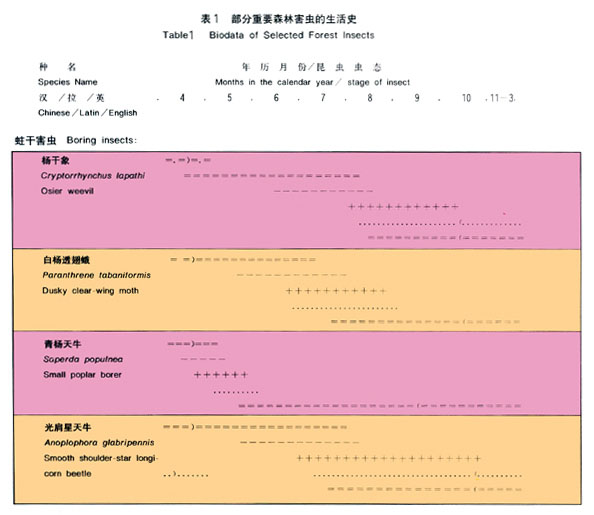

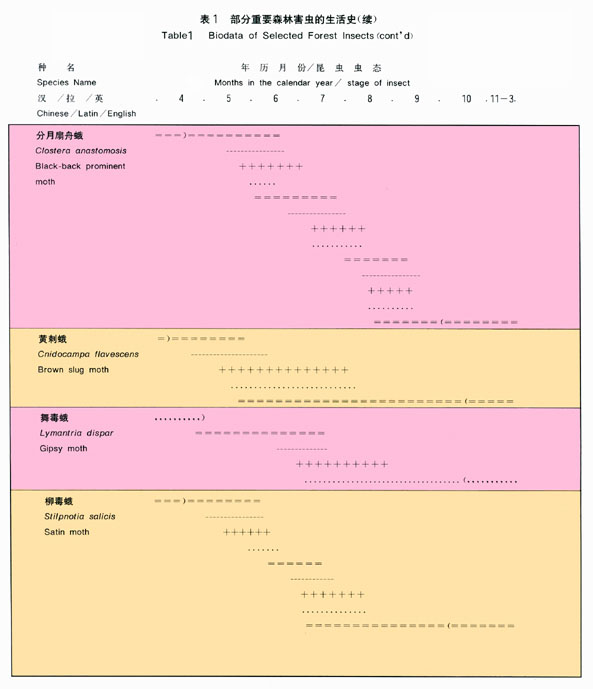
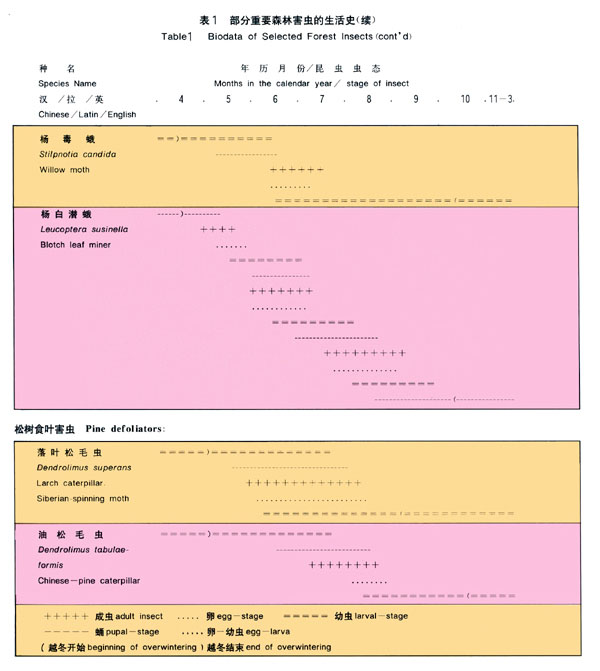
Specimens from the List of Forest Insects are described in the following section to make available to forest practitioners, detailed information on the appearance, injury, ecological data and control advice. In the following list, the insects are ranked on the basis of economic impact.
| Key-pests | ||
| Guang Jian Xing Tian Niu. | Anoplophora glabripennis | |
| Yang Gan Xiang. | Cryptorrhynchus lapathi | |
| Bai Yang Tou Chi E. | Paranthrene tabaniformis | |
| Luo Ye Song Mao Chong, | Dendrolimus superans | |
| Important pests | ||
| Da Yun Ban Sai Jin Gui, | Polyphylla laticolis | |
| Qing Yang Tian Niu, | Saperda populnea | |
| Da Qing Ye Chan, | Cicadella viridis | |
| Yang Shan Zhou E, | Clostera anachoreta | |
| Hei Rong Sai Jin Gui, | Maladera orientalis | |
| Common pests | ||
| Fen Yue Shan Zhou E. | Clostera anastomosis | |
| Huang Ci E, | Cnidocampa flavescens | |
| Yang Bai Qian E, | Leucoptera susinella | |
| Wu Du E, | Lymantria dispar | |
| Liu Du E, | Stilpnotia salicis | |
| Yang Du E, | Stilpnotia candida | |
| Yang Hei Dian Ye Feng, | Pristiphora conjugata | |
Key pest designation is based on the following criteria - the injury and economy threshold values of the pest are easily and quickly attained i.e. death of trees, or management targets of the plantation cannot be achieved without the application of efficient control measures. These measures against the pest are necessary especially in the nursery and high yield plantations.
Important pests are those that cause considerable damage under certain conditions. Control measures may be necessary: although even without control, the trees would seldom die.
Common pests cause increment loss only. As death of plants generally does not occur, chemical control is probably unnecessary. Treatment of nurseries and research plots may be exceptions, however.
| BORING INSECT | |
| Anoplophora glabripennis | CONTROL NECESSARY |
Characteristics: Adults are 2.5~3 cm long and 1 cm broad. Metallic-black, with irregular white spots. Long antennae, black with white and blue broad rings. Larvae, legless and white in colour, reaching up to 7 cm length.
Ecology: Widely distributed in China. Found on poplar, willow and elm in Dalinghe farm. In the city of Tongliao, mass outbreaks have occurred on ash—leaf maple, willow and poplar. The bolleana poplars are locally still attack—resistant. Leuce—section. Robinia, Fraxinus, Ailanthus, etc., are also attack—resistant. Poplars of the Sections Aigeiros and Tacamahaca, black poplars, simonii and other native poplars are prone to infestation. Beetles are found in summer and autumn, leaving the tree through a one cm wide, circular exit hole. Females gnaw an oval egg niche in the bark on the branches and stem. Coarse fibrous frass on trunk is an indication of attack. Normally one generation per year. Beetles are not flight active.
Economic importance Larvae can easily destroy the woody parts of the tree. Timber gets reddish—brown stains and loses all commercial value. Branches die first and thereafter the main parts of the tree. Most serious and severe pest of poplar in the region. Any spread has to be avoided by effective control measures.
Cross references Biodata, refer table 1. Control methods, refer chapter 4.1.2. 4.3.1.
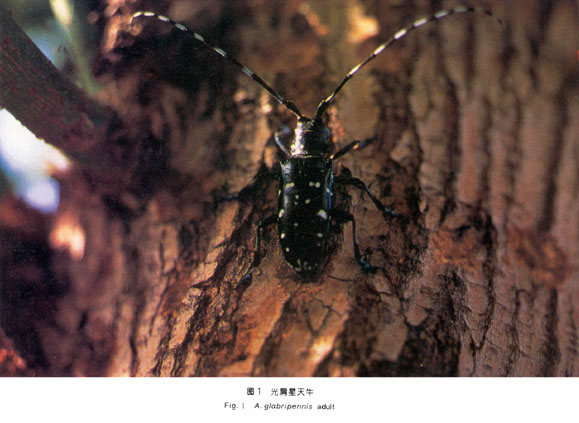
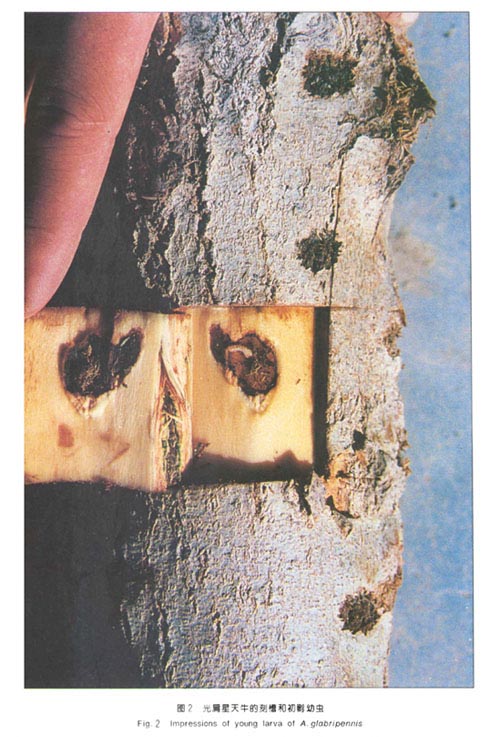
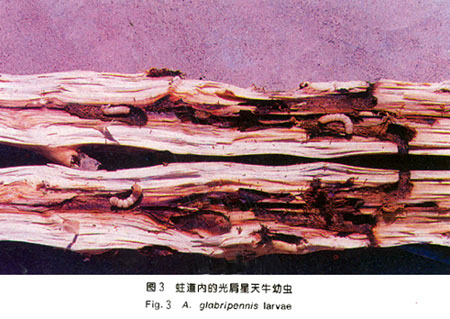
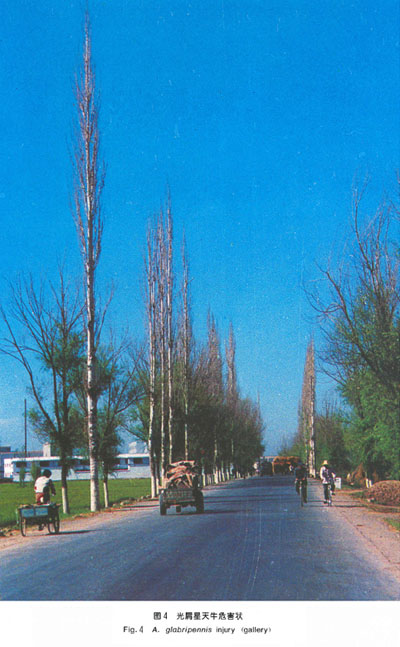
| BORING INSECT | |
| Cryptorrhynchus lapathi | CONTROL NECESSARY |
Characteristics: Small weevil, 8~10 mm long, snout bent to the body, oval-shaped, egglike, rugged surface. Dirty looking, black-brown colour. The sides of the head and tip of the bottom are white in colour. Larvae are grublike, horseshoe-shaped, thick and legless.
Ecology: In the project area found only in forest plantations of Liaoning Province. Larvae riddle the stems of young trees or tops of older plantations. Treetops, as well as stems of younger poplars and willows, break under heavy wind pressure. Female lays eggs in slits chewed into the bark. Larvae bore and destroy the cambium around the stem, then tunnel into the wood and pupate in the enlarged gallery. Adults emerge mainly in August, make a maturation feeding (bore holes into twigs) and lay eggs. If 10% of trees are attacked, control measures have to be applied. The pest does not spread quickly. Further symptoms include cancareous cracking of the bark, visible exit holes and lateral cracks, irregular swellings. To distinguish from similar pests: the Qing Yang Tian Niu, larvae are elongated and not grublike, and attack thin stems or twigs with typical round gall. The Bai Yang Tou Chi E attacks mainly stem of saplings and forms galls.
Economic importance: Can be very damaging, destroying treetops and younger plants. In plantations, control necessary when threshold exceeded.
Cross references: Biodata, refer table 1. Control measures, refer chapter 4.2.1. 4.2.2. 4.3.1.

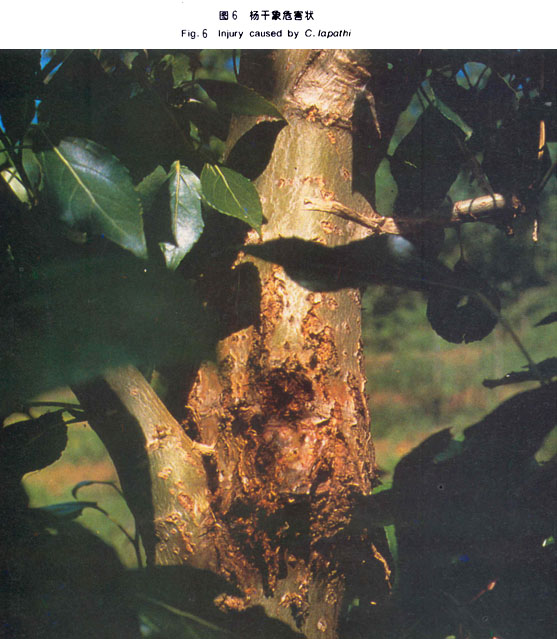
| BORING INSECT | |
| Paranthrene tabaniformis | CONTROL IN NURSERIES |
Characteristics: Moths, nearly 2 cm long and black-green with 5 transversal stripes on the body, have dark forewings and clear hindwings, resembling paper-wasps. Breeding sources have to be carefully checked as moths are not easily visible. To distinguish from Qing Yang Tian Niu, open galls or swellings appear on poplar stems. Larvae have short legs and may be white yellowish in colour. Gall on stem has no horse-shoe, U-like scar. Pupal case is outside the exit hole in July.
Ecology: Noxious in forest nurseries and young poplar plantations. The damage is stem breaking like the Yang Gang Xiang, but mainly on younger plants. Eggs are laid in crevices and wounds, and larvae destroy first the cambial tissue around the entrance, causing swellings and necrotic change of stems. Later, the larvae tunnel 6~8cm long into the core of the stem. Attack resistance known to some extent. Stems with bark ledges are more frequently attacked than smooth, round ones. Tacamahaca poplars are less infested than Leuce ones.
Economic importance: Heavy attacks in nurseries can cause the loss of growing stock and possible risk of the spread of the pest into new plantations where the stem breaking continues. Control and monitoring are necessary in the nursery when 5% of the stock is infested.
Cross references: Biodata, refer table 1. Control measures, refer chapter 4.2.1. 4.2.2. 4.3.2.
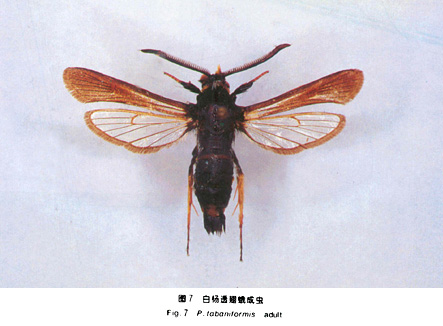
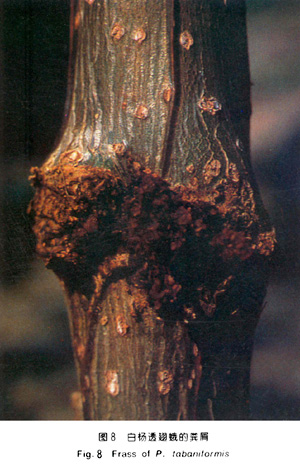 | 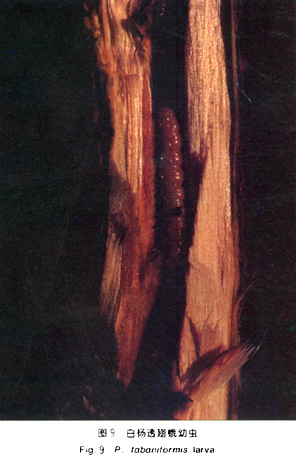 |
| PINE-DEFOLIATOR | |
| Dendrolimus superans | CONSIDER CONTROL |
Characteristic: The moth is big, 3~4.5 cm long with an open wing-span of 7~10cm. Large variety of colours as in all species of this genus with grey, black and brown being dominant. Caterpillars grow to a length of 6~9 cm. They are grey-brown with yellowish spots along the body. On the meso-metathoracic terga there are two black stripes with brush-like, toxic hairs. Near the tail, a long black brush can be observed in 8th abdominal segment. Caterpillars of You Song Mao Chong are silvery grey, with a deep brown spot on the forehead and a longitudinal dark stripe, whereas Luo Ye Song Mao Chong have a lateral ones.
Ecology: Pest of pines and larch. Mass outbreaks often start on driest and poorest sites. They are reported almost annually in Zhang-Wu Branch. A dangerous pest, widespread in northern China and Siberia in Russia. Caterpillars start to skeletonize needles in summer. Main damage however is caused in spring and early summer after caterpillars overwinter in the soil. Consequent defoliation over a long period leads to pine decline. The pest threatens all age classes of pines. However, many parasites and predators are normally present and should be considered when choosing a control method.
Economic importance: Most important pest of pines and larch in the region. As pines can die, monitoring is necessary in order to enable plantation managers to plan control operations in a timely manner.
Cross references: Biodata, refer table 1. Control measures, refer chapter 4.1.2. 4.2.2. 4.3.1.
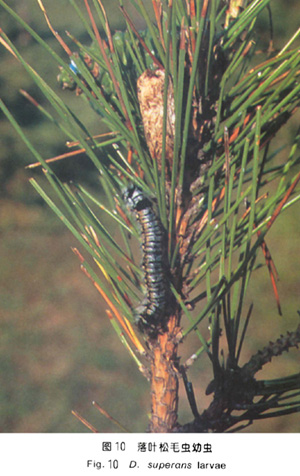
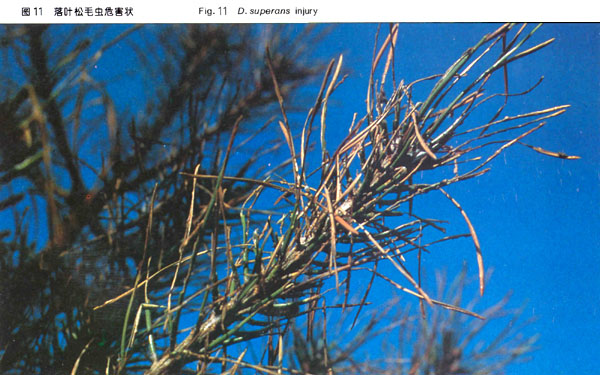
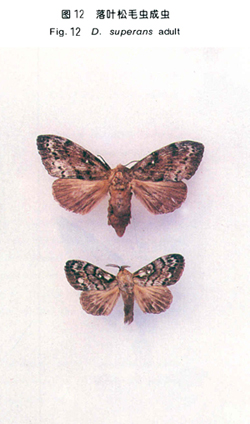
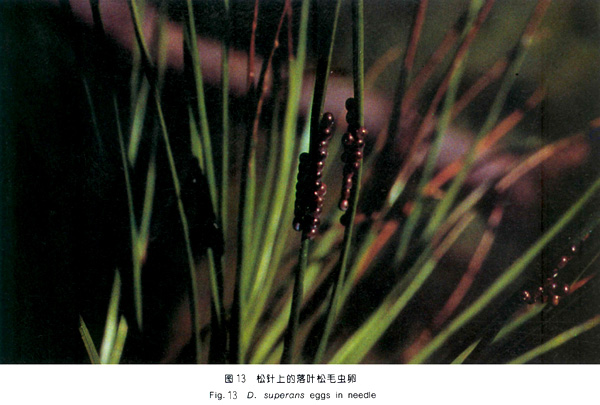
| ROOT FEEDER | |
| Polyphylla laticollis | CONTROL IN NURSERY |
Characteristics: Large beetle. 3~4 cm, elongated oval, clumsy, dark brown and dusty looking. Fore wings have white stains and dots. Antennae from the male combed with long lamellas. U-shaped grub occurs deep in the soil. Has long articulated legs and sharp jaws. Measures up to 8 cm in length.
Ecology: Represents a large group of plant feeding species. The grub are as injurious as root feeders as the adults are to foliage in spring and early summer. They feed on whatever species are available. The grubs need three years for development before reaching the adult stage and are obviously more damaging in the third year. A symptom of root attack is the flagging of the top leader of nursery stock and young plants. When digging out flagged plants, the damages are as follows: side roots are cut off, the principal root is peeled off and the bark is girdled. Raw compost fertilizing favours the pest.
Economic importance: Can be very important, but only in limited areas, especially in older nurseries. Damage occurs mainly in patches, not homogeneously over larger areas. To prevent losses in the nursery, control should be prescribed after monitoring.
Cross references: Biodata, refer table 1. Control methods, refer chapter 4.1.2. 4.2.1. 4.3.2.
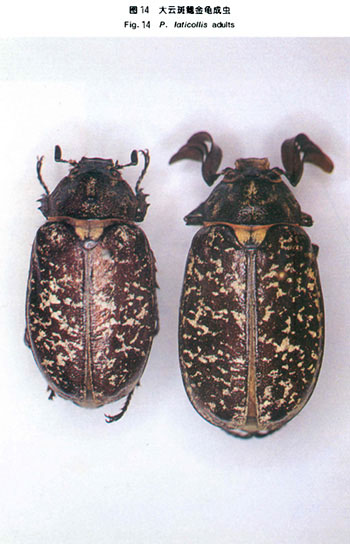
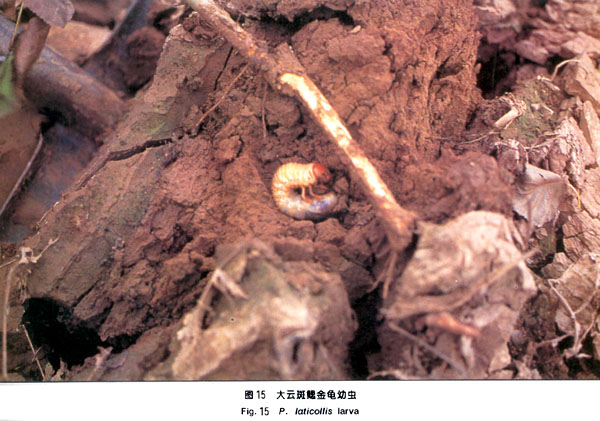
Saperda populnea
BORING INSECT
CONTROL IN NURSERY
Characteristics: Small, slim beetle. 10~15mm long, ground colour black with yellow stripes on the sides behind the head. Fore-wings with 5 golden spots each in a line. Legless larvae reach 10~15mm in length. The deep yellow colour distinguishes it from Bai Yang Tou Chi e.
Ecology: Widespread over Europe. Siberia and China on poplars. Very susceptible are Populus davidiana and Populus euroamericana. Lives in poplar twigs of all age classes. Eggs are normally laid in previous year's growth. A heavy attack does not affect large trees. Only in very young poplar plants on poor sites can heavy attack cause death. Good soil fertility helps the plant overcome the attack. Beetles emerge in a short period in May. Females lay eggs in U-shaped, horseshoe-like gnawn niches in the bark. Plant tissue reacts with a hammer-gall. The horse-shoe scar remains a significant symptom. Larva tunnels in the centre of the sapling or branch after having damaged the cambial tissue and sapwood which causes the gall. Exit-hole of emerged beetle is on the gall.
Economic importance: Damage is easily observed due to brown and broken branches in poplar stands, but is of little importance there. In nurseries, under poor site conditions and on weak plant material, severe damage can occur. Control measures under these conditions should be considered.
Cross references: Biodata, refer table 1. Control measures, refer chapter 4.2.2. 4. 3.2.
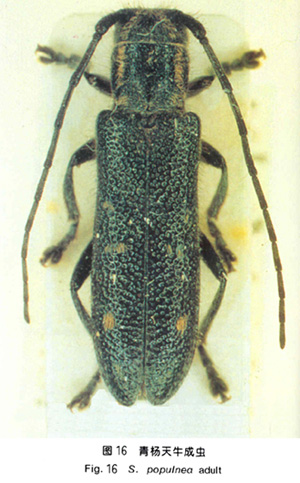
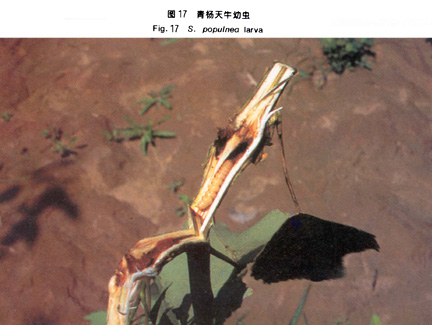

| INJURES BARK | |
| Cicadella (Tettigoniella) viridis | PREVENTION |
Characteristics: The grass-green leaf hopper is about 10 mm long and has a triangular, convex shaped head. Lives gregariously in large numbers. Adults jump quickly and far when disturbed (like grasshoppers).
Ecology: The sucking leaf hoppers normally live on cereal grasses and other herbaceous plants. Two generations of the insect are reported, the first thrive fully on crops, the second lay their eggs in characteristic openings (figure) gnawn by the female into the bark of poplar saplings, mainly in the lower portion. The eggs laid in late summer and early autumn, overwinter. Egg-clusters of 2~15 eggs can be found on every square centimetre of the smooth bark surface of the young plants. In spring the young larva, the nymph, moves to the herbaceous plants. The wound of the bark tissue creates a possible entrance for the weak pathogenic fungus Valsa sordida (Cytospora chrysosperma). The disease then causes a dieback of weak saplings or young plants. Resprouting is normal.
Economic evaluation: The insect is normally of little concern. Environmental stress, drought, wind, frost and the stem wounding, enable the feeble parasitic fungus associated with the insect to invade the plant and provoke the dieback.
Cross references: Control and prevention measures, refer to chapter 4.3.2.
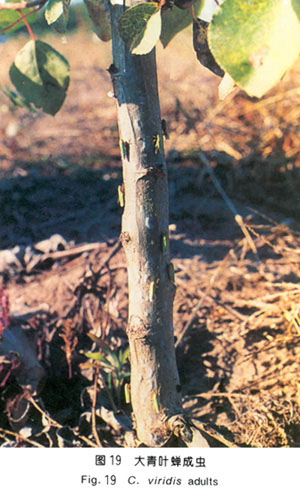
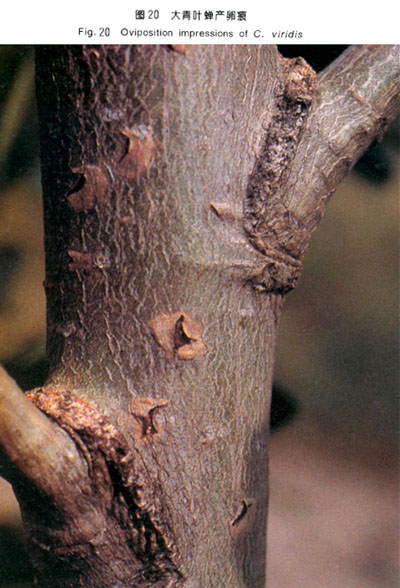
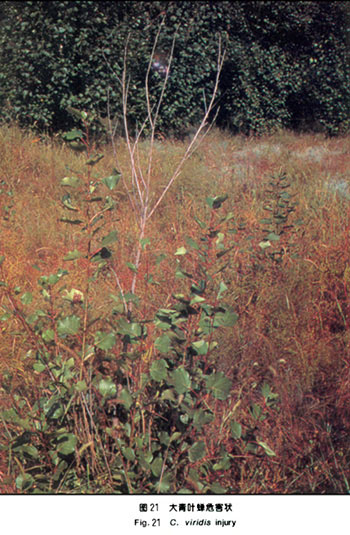
| DEFOLIATOR | |
| Clostera anachoreta | CONTROL IN NURSERY |
Characteristics: Moth 15~20 mm long, resting with the wings alongside the body in a roof-like position. Colour of the wings is grey, at the tips, brown, with white transversal stripes and an eye dot. Larvae up to 4 cm long, are grey to reddish-brown in colour and on the sides of the body, black with velvety warts on each segment. On the first abdominal tergum is a large red tubercle in a black transversal band with two white dots. Near the bottom end, at segment 8, there is also a red spotted tubercle.
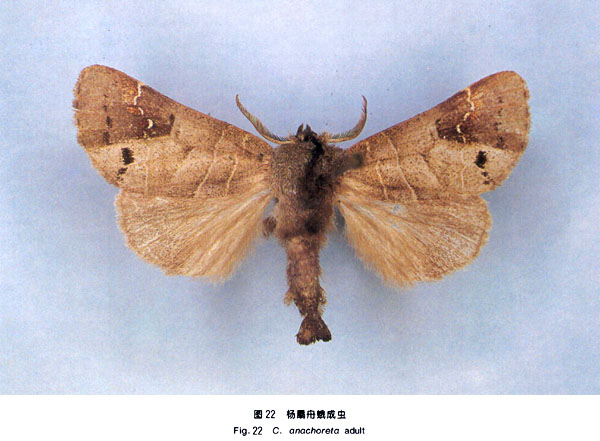
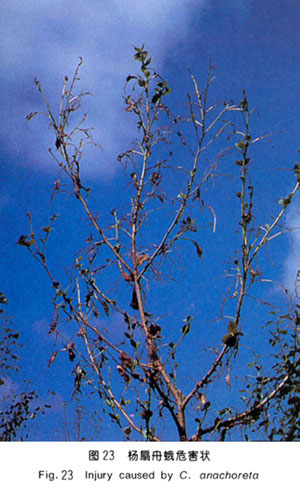
Ecology: Feed on poplars and willows throughout China. Three generations a year in the project area. Pupae overwinter in cocoons in the litter. Eggs of spring generation are laid on the stems, the other generations lay the eggs on the underside of leaf. Caterpillars usually defoliate only nursery stock and younger plantations. Most frequent in Liaoning Province and Inner Mongolia Autonomous Region. Older larvae spin webs on single leaves or tie several leaves together. At first, webs are silver and leaves green, later the leaves dry out and turn to blackish-brown in colour, remaining so for a long time on the plant or tree.
Economic importance: Only in nurseries can saplings be severely defoliated and have their growth retarded. Apply control measures if 10% of nursery stock is heavily attacked. Apply Bacillus thuringiensis (Bt.). Use of chemical insecticides is not recommended.
Cross references: Biodata, refer table 1. Details for control, refer chapter 4.2.2. 4.3.2.
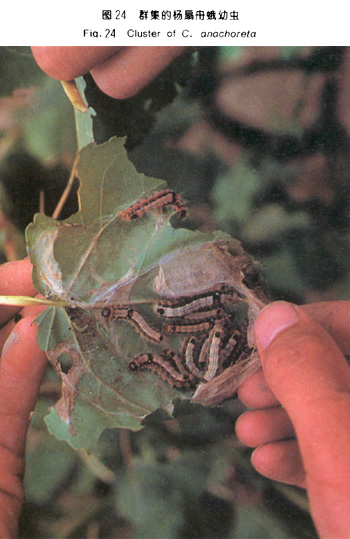
| DEFOLIATOR | |
| Clostera anastomosis | COMMON PEST |
Characteristics: Moth, 15–20 mm long, resembles the Yang Shang Zhou E in appearance except that the brown tip of the wing in this species is dusky-red. Three grey-white transversal stripes can be counted. One round spot in apical area of median cell is dusky-brown, separated into two equal parts by a fine grey-white transversus stripe. Larvae, 4 cm, have large tubercles on the first abdominal tergum.
Ecology: Feed on poplars, willow and birch. The species is widely distributed, and locally, it has three generations a year. The third instar larva overwinters in a thin cocoon in the ground. Each female lays 500 or more eggs. The young larvae skeletonize on leaves and later eat up the edges of leaves. Mature larvae eat whole leaves. Spectacular defoliation can often be observed, but plants normally recover. Broad-leaf trees, especially poplars, which suffer sequential and periodical defoliation, will not die, but will show a considerable incremental loss.
Economic evaluation: Even heavy and frequent defoliation generally cause only a loss of increment and no dieback. Stunted growth can also be observed in such cases. Generally older plantations are defoliated and therefore pesticide treatment is generally not needed. In special areas e.g. research plots, a treatment with Bt. from aircraft can be considered.
Cross references: Biodata, refer table 1. Control measures, refer chapter 4.1.2.
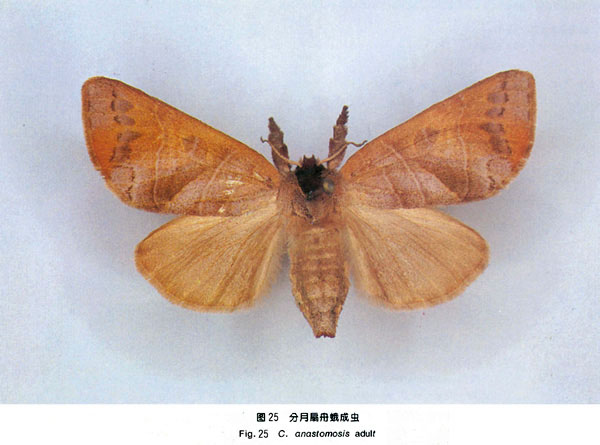
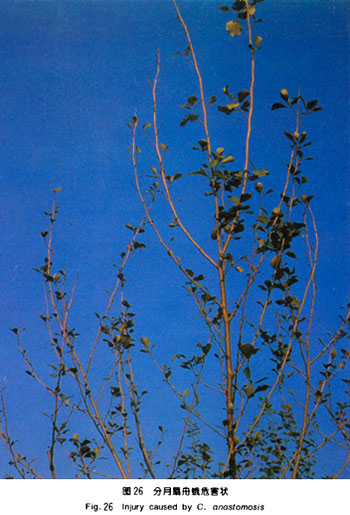
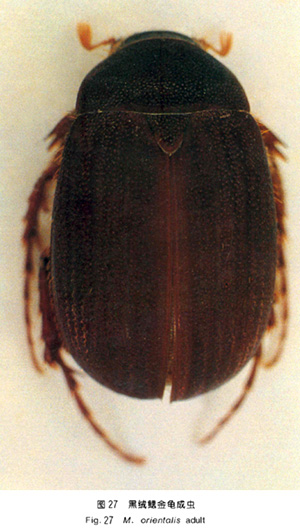
| BUDS AND LEAF FEEDER | |
| Maladera orientaris | NURSERY PEST |
Characteristics: The beetle is only 8 mm long and 4 mm broad. oval-shaped, brown when emerging, then metallic-black with velvety, reddish-brown, lamellate antennae. Grublike larvae. 15 mm long. U-shaped with milky-white legs.
Ecology: The damage by the beetle is more important than the injury on the roots of nursery stock or plantation trees by the grubs. Damage is reported on 150 plant species in China including poplar, willow, elm, and many fruit trees. The beetle has one generation and overwinters in the soil. It emerges in spring at some time earlier than flushing of foliage of poplar and other species. The beetle feeds on buds and tender leaves in May and June. Under heavy attack, forest nursery stock loses buds and leaves in spring and withers when flushing. In such cases, control measures have to be applied to avoid losses. However, only small areas are involved.
Economic importance: Normally the insect is considered a minor pest. In exceptional cases, as reported from the Jian-Xin Branch, it can cause some trouble and therefore nursery technicians must be alert in early spring to take action and apply control.
Cross references: Biodata. refer table 1. Control methods. refer chapter 4.1.2. 4.2. 1.4.3.2.
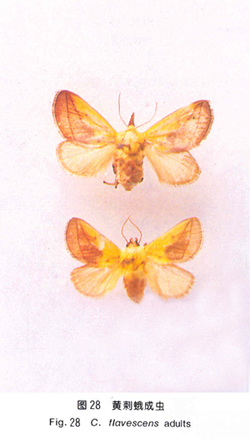

Cnidocampa flavescens
DEFOLIATOR
COMMON PEST
Characteristics: Moth. 15–17 mm long. wing-span up to 40 mm. with body, orange in colour, forewing, brown and hindwing. yellowish—grey. Thick scales on body and wings. Caterpillar is 25 mm long, stocky, sturdy, and yellowish—green in colour. Has a greenish—grey, dumbbell—like stain over the back. and short. ramified appendices, and nettle, rash—causing toxophors. The pupae. each up to 15 mm long. in a hard, hemisphere—like cocoon, dark grey and white in colour. stick at the bark of stems and branches.
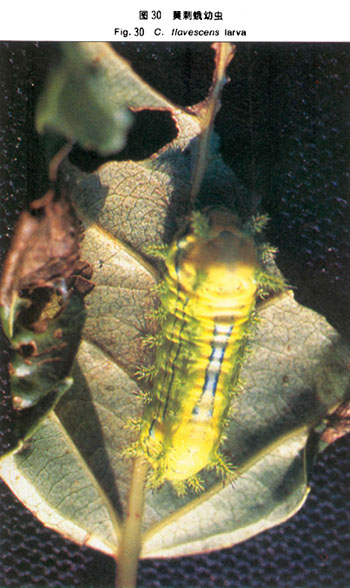
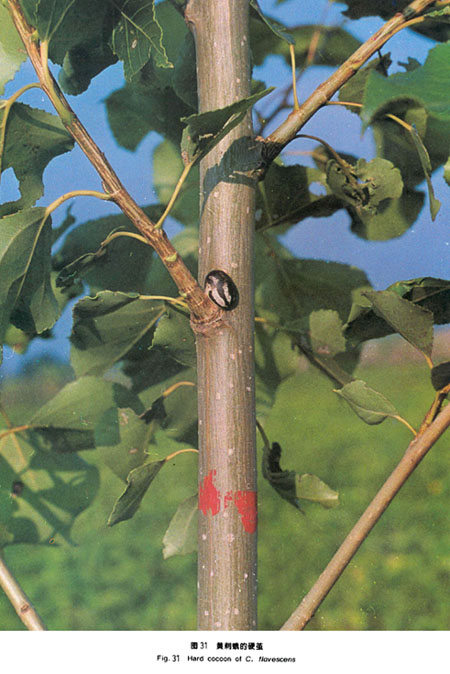
Ecology: Distributed almost all over China and feed on many tree species such as poplar, willow, birch, elm, oak, plane trees, maple, fruit trees etc. In the project area, it has one generation per year. The mature larvae overwinter in hard cocoons. The adults are active at night and are not attracted to light. Caterpillars do not spin and they feed freely on leaves. Complete defoliation is reported only from outside the project area. The defoliation has no damaging effect and recovery of trees is reported. In forest nurseries, the caterpillar is a threat to human health, due to the toxic hairs which cause nettle—like rash. Control methods to protect staff are necessary.
Economic importance: Poplars recover after defoliation and only a small loss of increment can be expected. Because larvae can cause health problems to workers, protection is needed.
Cross references: Biodata. refer table 1. Control measures. refer chapter 4.2.2.
| LEAF MINER | |
| Leucoptera susinella | NURSERY PEST |
Characteristics: Small, silvery moth, 3~4 mm long. with wing—span 8~9 mm. The lance—shaped hindwings have long marginal hairs. Mature larva, 6~7 mm long, are flat and pale yellow in colour. The pupae are 3 mm long in a white cocoon.
Ecology: Mines into poplar leaves only and distributed in the north and northeast of China. Locally, the miner has three generations a year and the pupae overwinter in fallen leaves on ground. The moth is attracted to light and lays eggs on the upper side of leaves in clusters. Larvae then enter the leaf tissues and feed on the parenchyma. The symptoms of attack are mines and blotches of black—brown tissue where the leaf is hollowed out. The damage caused by the pest is loss of leaves and early leaf fall.
Economic importance: The pest is of little concern, but due to the black blotches its existence is obvious. Control can be accomplished by manual picking of blotch mine leaves. 80% of leaves of nursery stock attacked would be a threshold value to start control measures. There are other leaf miners also in poplar nurseries. In August, a serpentine leaf miner can be observed. A silver, shiny, snail track-like path is the symptom.
Cross references: Biodata, refer table 1. Control measures refer chapter 4.1.2. 4.2.2.
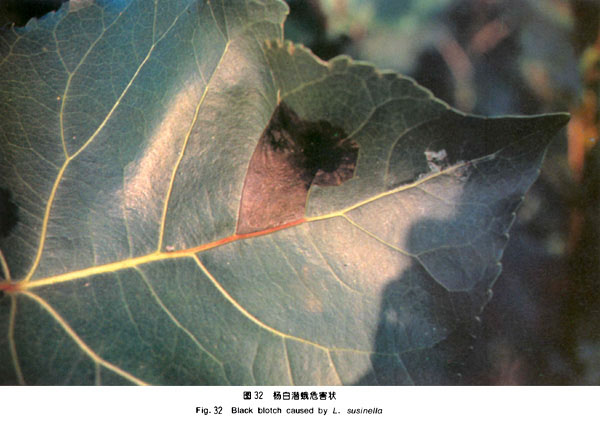
| DEFOLIATOR | |
| Pristiphora conjugata | COMMON PEST |
Characteristics: A little wasp. 6–8 mm long. metallic—brown with transparent wings. Mature larva. 15–17 mm long, yellow—green in colour with brownish—black head. Larva has tiny black spots on back and sides and resembles a caterpillar, except that ther are 7 pairs of abdominal leg without crochets which are not found on a caterpillar.
Ecology: Feeds on poplar leaves in the northeast of China. In the project area this insect is mostly seen in Inner Mongolia Autonomous Region and Liaoning Province. The insect has five generations a year, the pre—pupa overwinters in a cylindrical cocoon in the soil. 2–3 cm deep. Larvae feed jointly in family groups from the margin into the centre of the leaf. When disturbed, they lift their bodies up, stick—like, and remain for a certain time in this position. They spit and often a blue—white. waxy thread remains on the leaf (figure). The damage is an ongoing defoliation over the summer. Poplars recover even after severe defoliation.
Economic evaluation: The pest causes defoliation only. A certain loss of increment can be expected. Young poplars of the Aigeiros section are usually attacked in the Jin—Xian forest farm. In the Naiman farm, young robusta poplars are attacked. No chemical control is recommended.
Cross references: Control applications. refer chapter 4.1.2. 4.2.1.
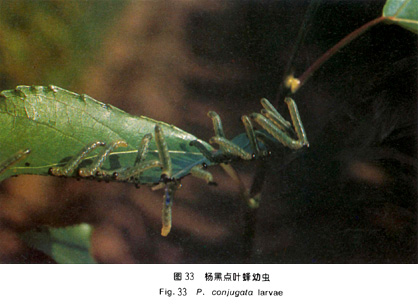
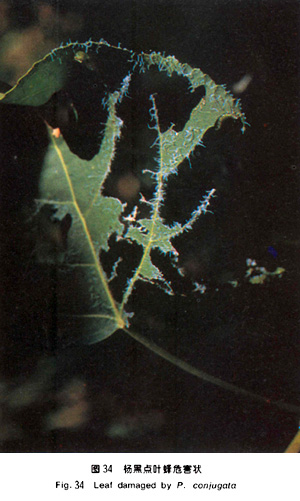
| DEFOLIATOR | |
| Stilpnotia (Leucoma) salicis | COMMON PEST |
Characteristics: White moth. body up to 2 cm long. wing—span 4–5 cm. Legs with black and white rings, which distinguish it from Mei Guo Bai E another white poplar defoliator. Caterpillar is black with yellow—white spots on the back and measures up to 45 mm long. The Lymantrid gland on the 6th–7th segment is brown to distinguish it from Yang Du E another white coloured Stilpnotia moth whose similar caterpillar has reddish colour gland tubercles too. The tubercles on the side of the segments are hairy and reddish brown.
Ecology: Defoliates poplars. willows. hazel. maple and Chinese ash. The insect has locally two generations (Yang Du E has one). The moth is strongly attracted by light. which is typical of the Lymantrid moths. and may lay egg—clusters of up to 100. covered later by a hard white foam. Larvae skeletonize in the young instars. Later the whole leaf will be eaten. leaving the leaf stalk only. Heavy defoliation caused by this pest occurs all over the northern hemisphere. Chemical treatment should not be applied on trees resistant to the defoliation.
Economic importance: Even heavy defoliation during both generations in one year causes only a growth reduction and incremental loss. Pests look spectacular and threatening, but do not cause tree decline. Normally no treatment is necessary, but in rare cases, to protect trial plots. Bt. spraying is recommended.
Cross references: Biodata, refer table 1. Control measures. refer chapter 4.1.2. 4.2. 1.
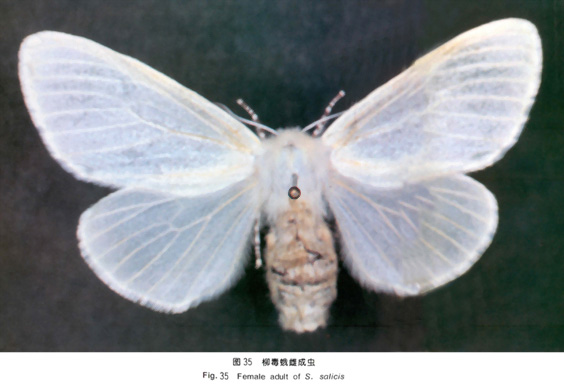
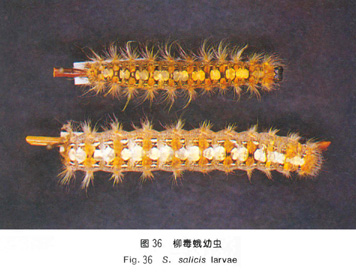
| DEFOLIATOR | |
| Lymantria dispar | COMMON PEST |
Characteristics: Female moth. 3.5 cm long. is much larger than the male and is yellow—white in appearance. Male is greyish—brown with dark brown. zigzag lines and bands on forewings. and uniformly brown with dark edges on hindwings. Moth rests in a form like an equal—size triangle. Caterpillar, up to 7 cm long. has two brown longitudinal stripes with blue and red coloured dots on the back. The first five pairs are blue, the next six pairs are red and the last pair is again blue. The larva is hairy but without brushes. The eggs are laid in clusters of several hundred coated in a yellow felt. on the bark of trees or anywhere. Each oval cluster can measure up to 5cm×3cm.
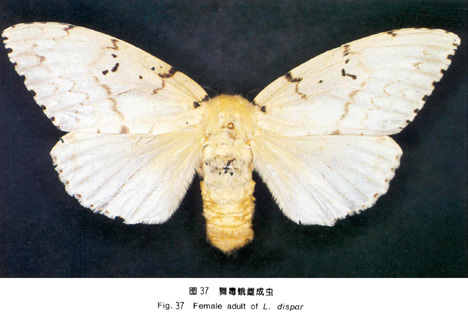
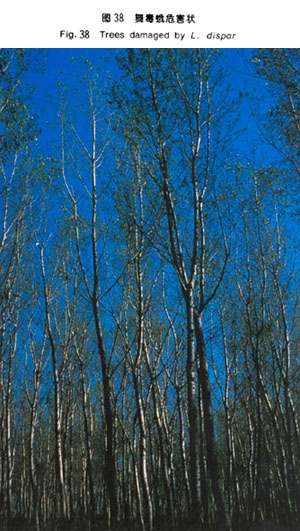

Ecology: Widely distributed over the northern hemisphere. Polyphagous on broadleaf and some conifer species. In China, the larvae feed on fifty species of plants, especially on poplar, willow, birch, oak, elm and fruit trees. One generation per year. eggs over-winter. The eggs are exposed to parasites and predators for nearly nine months. which help considerably to reduce the pest. Larvae feed in June and July, but from mid—August, poplars and other attacked species can recover and refoliate. Mass outbreaks are frequently observed, sometimes periodically. Mature plantations and stands preferred.
Economic importance: The defoliation generally does not cause the death of poplars. only growth reduction and increment loss. Control measures like pesticide application can be avoided under normal conditions.
Cross references: Biodata. refer table 1. Control policy, refer chapter 4.1.2. 4.2.1.
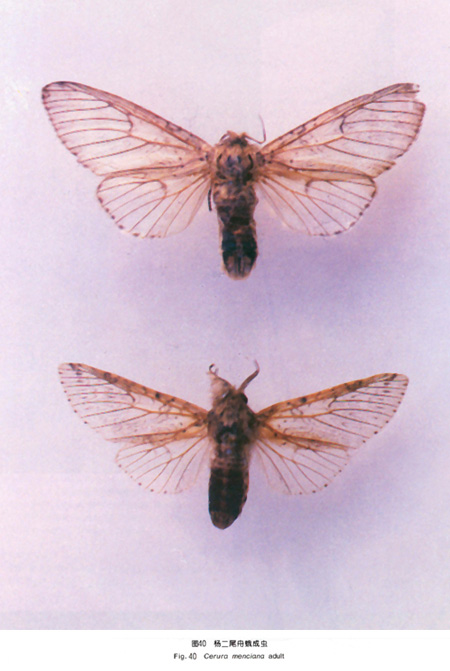


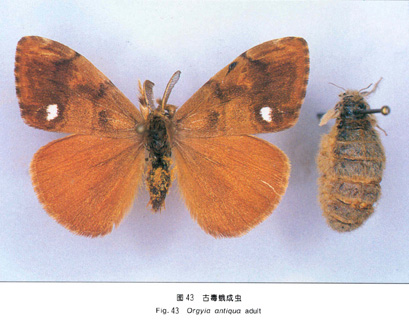
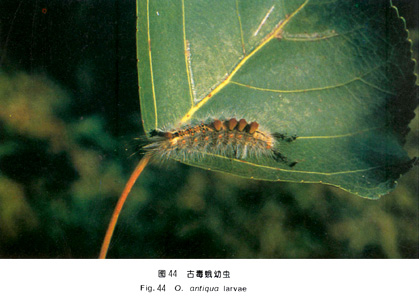
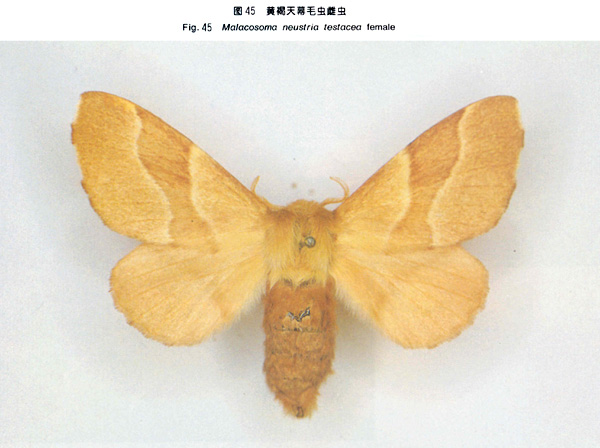

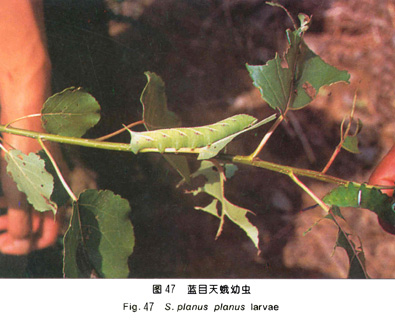

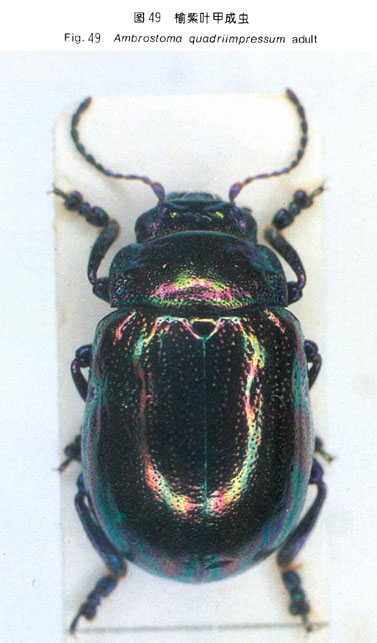
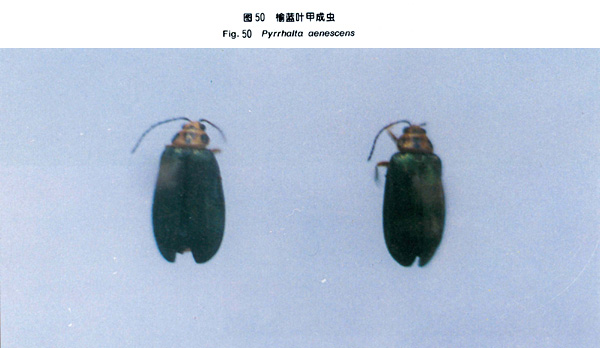

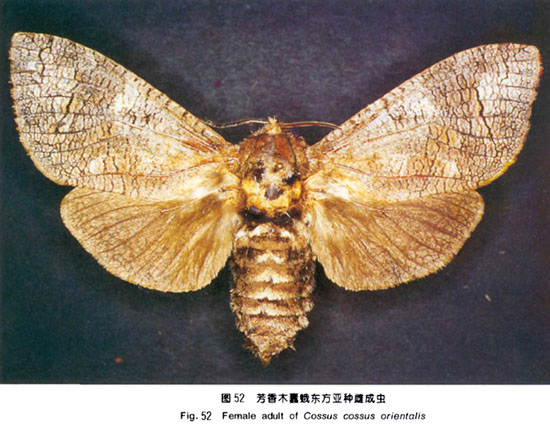
4.1.1 Developments in Pest Management
The occurrence of forest pests has always been the prime concern of foresters. For a long time, foresters had no effective chemical tools for the control of these pests until the introduction of agrochemicals. Inorganic arsenates were the first tools and, in the 1940s. DDT opened the path for the development of organic pesticides, followed by phosphoric esters and then systemic insecticides. At present the application of UV—radiation stable pyrethroids is common.
Pests often infest the same site several times, and control methods, repeatedly applied, increase costs. Pest resistance as well as an increase in environmental pollution and residue problems can occur as a result of repeated pesticide application. Depending on the type of pests, different methods of control were applied in sequence or concurrently, including the use of pesticides which was not only chemical based. Pest control became more complex, more expensive and, even in the shortrun, less effective. There was no coordination. Pest survey and monitoring were conducted whenever there was evidence of noxious pests. Whenever damage appeared, people should either undertake immediate actions, like cut—and—burn or pesticide application, or ignore it considering that damage with all its consequences is acceptable.
The introduction of modern management practices in forestry, based on scientific findings and practical experiences and changes in agricultural practices, have created a new and now widely accepted situation — the development of the Integrated Pest Management (IPM), which now considers also the host plant of the pest in its philosophy. A holistic system exists now: the pest, the plant and the environment in a scheduled plan of activities.
Insect survey on a regional basis, the monitoring of insects on site in nurseries, plantations and forest farms, the introduction of threshold levels i. e. the injury to the plant and the economic aspects of the method to be adopted, and the decision for suitable control application, are issues to be taken into consideration under this strategy. Furthermore, the various possible control methods — mechanical, chemical, biotechnical, biological are to be used. The use of prediction tools like pheromone, light trapping, counting of insect stages on overwintering sites, evaluating damage percentage etc. the introduction of insect occurrence or damage reporting systems, the application of pest prevention methods, the silvicultural practices, species selection, the use of pest resistant clones, provenances and species etc. are integrated into the concept of the IPM.
IPM in forest protection is paramount for the establishment and maintenance of sound, vigorous plantations and stands and the production of vigorous planting stock in the nursery.
4.1.2 Forest Protection Strategy Model
In case of damage to forest plants, foresters have to respond immediately by evaluating the pest impact i.e. its lasting effects and the form of control to be chosen. The control method chosen must be justifiable. The main criteria should be the injury threshold level of the forest plant, the economic threshold level for the forest enterprise and the effects of treatment on other resources. Furthermore, the legal context must be respected and the public value of the forest or plantation and its overall functions must be considered. The following are recommended models for decision making:
Pests causing the death of trees or plantations: Effective Control methods have to be applied immediately. The pests referred to here are the key—pests. The injury threshold level of the forest plant, poplar or pine, for the purpose of this project is defined on the basis of experience locally obtained. To justify application of pesticides or other effective control methods, injury must exceed this threshold level. Examples of pests which require application of immediate control are:
The key—pest Guang Jian Xing Tian Niu. Anoplophora glabripennis, is reported for the first time in a poplar plantation. The objective is to avoid the establishment of an extremely noxious pest in a previously uninfected area.
There is a mass outbreak of the key pest Lao Ye Song Mao Chong. Dendrolimus superans, in a pine plantation for the second successive year. The objective is to prevent the decline of the pine in a sand—dune stablised area.
Da Yun Ban Sai Jin Gui. Polyphylla laticollis. an important pest, needs to be controlled to protect the rooting of the cuttings and to prevent the saplings in the nursery from death.
A mass outbreak of Fen Yue Shan Zhou E. Clostera anastomosis, has occurred in an older poplar plantation. In this case, pesticide application is not justified.
Pests which cause effects which normally do not influence the economic or ecological objectives of the plantation: The crop will not die and control methods, although not a necessity, can be applied. Some key—pests, mainly in nurseries and young plantations, and important pests are included in this category:
In the nurseries and research plots, control is recommended for Bai Yang Tou Chi E. Paranthrene tabaniformis, and Da Yun Ban Sai Jin Gui. Polyphylla laticollis, in order to protect the rooting of cuttings.
The key—pest Yang Gan Xiang. Cryptorrhynchus lapathi, has infested a young plantation by ten percent. The objective is to control this economically important pest and to avoid its establishment as the beetles cannot spread easily because they do not fly. In this case, the economic threshold value is more important than the injury threshold level. The poplars can survive an attack, but the target for a high yield plantation, e. g. to produce straight poles, will not be achieved.
Pests which cause increment loss only: No chemical control measures are required as the crop will not die. If experience shows that heavy defoliation of poplars and other broadleaf trees do not cause tree mortality, then the pests, even if they are evident, are economically harmless, as long as they do not cause growth loss, top dieback or other damaging effects. Common insect pests prevalent in older plantations, can all be considered under this category. Hei Rong Sai Jin Gui. Maladera orientalis, which attacks poplar saplings heavily and destroys the buds in early spring may be an exception.
4.2.1 The Forest Nursery
Forest protection has also several requirements to be met in the nursery. The nursery is the production site for vigorous planting stock and must receive the necessary attention in order to reach its objectives. High quality planting stock, picked out at the right time from the nursery and correctly planted on a proper site, will receive minimum replanting shock and will be less exposed to pests in the first growing season. As a result, rapid but proper root development will be facilitated. In this view, forest protection requirements in the nursery should be as follows:
The physical and chemical properties of the soil must be correct. Different plant species may have differing soil requirements. Proper soil tending influences sound root development. The spacing in the nursery should be right i.e. it should be relative to the height / diameter of the plant. A thin plant will be more susceptible to pests and diseases in the plantation. The irrigation systems must be adequate etc.
The location of the nursery also has an effect on forest pests. For instance, a poplar nursery should not be situated inside a forest or plantation but at some other place out of reach of forest pests which do not fly. There should be no cornfields in the surroundings of a nursery because cornborers also attack poplars. The infrastructure of the nursery is also an important consideration. Storage of pesticides must be in a separate building to avoid contamination. A special room is needed to store protective clothing for pesticide application and a separate washroom according to hygienic standards is to be set up. The nursery must be served by all—weather road and electricity.
Mechanical control including trapping: Whenever forest technicians are aware of insect damage on a small scale, mechanical control by cut-and-burn, should be applied. This technique is the best control against the boring insects. Paranthrene tabaniformis, Cryptorrhynchus lapathi and Saperda populnea. Light trapping of the insects is a good example too. It can control the Da Yun Ban Sai Jin Gui. Polyphylla laticollis and Hei Rong Sai Jin Gui. Maladera orientalis. In the case of agro—chemical control, the application of it in the nursery differs considerably from its application in the plantation or forest stands. On production sites, there is greater emphasis on the use of pesticides and fertilizers in order to generate healthy and vigorous young stock for replanting into plantations later.
The use of agro—chemicals and pesticides in the nursery: Fertilizers, should be used in accordance with soil analysis data. Soil fumigants and fungicides will control damping—off by fungi and other pathogens. Insecticides should be applied when mechanical treatment cannot reduce the individual pest threat to below threshold levels. Insecticides should be used to control key—pests, important pests and, only on the common pest. Hei Rong Sai Jin Gui. Maladera orientalis, the bud and leaf feeding pest. Outbreaks of other common defoliators as listed should not be controlled by means of insecticides. If more than three percent of poplars are infested by the pest Bai Yang Tou Chi E. Paranthrene tabaniformis injection of a insecticide composed of Trichlorphon 25% oil solution and Chlorpyrifos — Dursban 40% EC into the bore hole is recommended. Alternatively, the saplings should be drenched in Cypermethrine 10% EC, or Deltamethrine — Decis 2.5%EC. The treatment should be applied at the end of June and repeated one month later.
4.2.2 Direct Control Methods: Young plantation and nursery
Physical — mechanical: To cut — and — burn remains one of the traditional but successful methods without endangering the environment. It should be used in all cases where the pest population is low. Stem borers, especially Qing Yan Tian Niu. Saperda populnea, should be controlled in this way. Plants on highly fertile soil can quickly overcome an attack by this pest but on poor soils this pest will seriously affect the feeble plants. Light trapping, especially of moths, and other forms of traps e.g. sticky rings and traps are to be mentioned here.
Chemical methods: In plantations, pesticides should be used selectively. As the objective of plantations in most cases is towards preventive control of pests, generally application of insecticides is not recommended in poplar plantations. The high yield plantations in the Dalinghe Farm should control Yang Gan Xiang. Cryptorrhynchus lapathi. The application should be terrestrial, using the already proven method of pesticide application by brush. Furthermore, the locally positively tested products like the Pyrethroids Cypermethrine or Deltamethrine—Decis mentioned above could be used with good results. Treatment by applying the phosphoric esters Chlorpyrifos — Dursban. Fenitrothion — Sumithion. Trichlorphon — Dipterex will ensure 95 mortality of pests on treated plants. Chemical treatment especially by aircraft will occasionally be necessary in plantations to control mass outbreaks of Luo Ye Song Mao Chong. Dendrolimus superans, in areas where this pest have thrived for more than one year and have caused 100% annual defoliation. Pyrethroids as already indicated, and Dimilin — Diflubenzuron can also be utilised. The latter, a moulting inhibitor, is applied by ULV — Application. This agent is especially potent on the phytophagous caterpillars. Note that biological control agents can alternatively be applied. Refer to Trichogramma and Bt. mentioned under paragraph 4.3.1.
Biological methods: The use of egg — parasites should be enhanced. China has a long tradition in the use of this control method and has the proper technology to breed Trichogramma sp. in farms. The Dendrolimus spp. control method should be applied generally in nurseries to reduce common defoliating pests including Yang Shan Zhou E. Clostera anachoreta. Insecticides should not be used to control moth — caterpillars in nurseries and research plots. The biological insecticide. Bacillus thuringiensis, should be applied instead. The general support for biodiversity, in this case, the breeding of useful insects like predators and parasites should be considered as a pest prevention activity and initiated as a regular programme in all forest farms. This programme includes intercropping and planting of shrubs and flowering herbaceous plants on the surroundings of nurseries and forest plantations, to re—establish favourable breeding conditions for predators and parasites.
Biotechnological methods: The use of insect pheromone should be tested. In Tongliao, a pheromone for Bai Yang Tou Chi E. Paranthrene tabaniformis has been developed and is in use. Pheromone has been shown to be an effective tool for monitoring and in some instances can also be used as control methods.
4.3.1 Key Pests
Guang Jian Xing Tian Niu. Anoplophora glabripennis:
If the pest is at a low population density level, the objective should be to
prevent its propagation and further spread. The recommended measure is to
cut and burn infested trees completely and not to use insecticides. Initiate a
monitoring programme for the pest locally. When the pest is at a high
population density level, as in the city of Tongliao where a threat to forest
plantations near the city exists, city authorities should arrange to plant non
host trees like conifer trees. Robinia pseudoacacia, Fraxinus sp., Quercus
sp. in alleys and house gardens and outer parts of the city. In this way
the isolation belt created will prevent the spread of the pests and ensure the
safety of forest plantations.
Yang Gan Xiang. Cryptorrhynchus lapathi:
As this pest, a beetle, cannot fly and is a slow invader, the objectives are
to avoid its establishment in plantations where the pest does not prevail and
if it does, to minimize damage especially in yield plantations. A pest monitoring
and reporting programme should be set up. In the event of first
evidence of the pest, a complete inspection and then an eradication programme,
in the first instance, without insecticides should be carefully
planned. The following measure of control is recommended: cut the poplars
below the breeding portion and burn the attacked material outside the
plantation. Identify the leader to obtain a new single — stem crown and
prune accordingly. The control by insecticides, as described under paragraph
4.2.2 Chemical Methods, should be applied in the yield plantations and
around forest nurseries.
Bai Yang Tou Chi E. Paranthrene tabaniformis:
For this pest in plantations, if strong planting stock, like 3/1 or 4/1
saplings are planted, its impact will not be severe. Hence the objective will
be the production of sound planting stock in the forest nurseries as a kind
of control measure especially against this pest. Saplings like 2/1, 3/1, or
even 4/1 as planted in Tong — Yu branch are the best in terms of age and
size against this pest. In rare cases, if it does exist, the pest can be
eradicated by drenching the stem of the infected plant. The treatment as
described under paragraph 4.2.1. by the use of agrochemicals and pesticides
in the nursery. However, the use of insecticides should be limited to the
high yield plantations. Injection technique is not appropriate in this case.
However, the use of insecticides should be limited to the high yield plantations.
Injection technique is not appropriate in this case.
Luo Ye Song Mao Chong. Dendrolimus superans:
The objective is to protect pine plantations from defoliation which can cause dieback,
growth loss and tree mortality. Conifers are more susceptible to defoliation than the
broadleaf species. A pest monitoring programme is necessary to map and evaluate the annual
presence of defoliation in plantations. The control method as described in detail in paragraph
4.2.2 can be applied in this case. The biological method. Trichogramma, egg parasite release
can be supported by spraying Bt. Bacillus thuringiensis, which is harmless to the egg
parasites present. Control should be applied preferably in early August against young larvae,
which are much more susceptible to the agents used than the big, old caterpillars after
overwintering in spring. Control at ground level is possible if the outbreak area is small and
the plantation is not higher than 5m. The majority of treatments is by the use of aerial
sprays by aircrafts. Heavy winds in spring, however, limit its use.
4.3.2 Important pests
Da Yun Ban Sai Jin Gui. Polyphylla laticollis:
The objective is to protect cuttings in nurseries against root debarking and loss of fine
rootlets caused by the pest which affect the growth of vigorous saplings. The forest farm
thus infected should record the cycle flight years of this beetle. According to the biodata the
insect has at least a three — year development period. Cuttings brought to ground in the
second and / or third year after the main flight year, should be soaked in a soil — stable
insecticide and the soil around the planting hole should also be spot — treated. Pyrethroid
insecticides will not give good results but Chlorpyriphos — Dursban should provide protection.
A routine soil treatment with insecticides should not be carried out if there is no indication
of high grub population. The beetle population should be reduced by routine
catching and light trapping. If the beetle defoliates plants in the nursery, routine insecticide
application can be carried out to reduce and prevent egg laying in the soil.
Qing Yang Tian Niu. Saperda populnea:
The objective will be to produce vigorous saplings in the nursery. The pest is less dangerous
than the above mentioned boring insects. In the nursery, during the second growing season,
this pest begins to injure the stems. Normally the cut-and-burn method should be applied
and the population could be reduced by isolating infected sources near the nursery. Nevertheless,
there are cases where 7–8 galls can appear on one young stem and spread to almost
all saplings. In this case, the economic threshold has been surpassed and insecticides
should be applied. The control method, similar to that against Bai Yang Tou Che e. i. e.
by drenching stems with a Pyrethroid like Cypermethrine at the beginning of the flight
period of the beetle. No chemical treatment is to be considered in plantations. Experience
shows that damage impact decreases with increasing soil fertility. Good growth of the plants
reduces the risk of stem breaking.
Da Qing Ye Chan. Cicadella (Tettigoniella) viridis:
Harsh environmental conditions, poor plantation site, weak planting stock,
leaf hoppers and the presence of the secondary parasite Valsa sordida, can
produce the dieback of the first annual growth of the poplar plants. The
plants however, do not die, but the damage will cause a loss of one year's
growth. The dead leader is an indicator of the overall infertility of the site.
No chemical treatment is necessary. Select one leader by cutting out the other
resprouts, using pruning scissors. More vigorous planting stock should be introduced
into areas of known high risk to the pest.
Yang Shan Zhou E. Clostera anachoreta:
These insects can reduce the vigour of planting stock in the nursery and, as
defoliators they can severely attack young saplings causing growth reduction.
As already stated in the description of the species, the use of Bt can be
considered for control purposes. Alternatively, the moulting inhibitor Dimilin
could be used. No treatment in plantations is recommended.
Hei Rong Sai Jin Gui. Maladera orientalis:
The objective is to protect planting stock in the nursery. This beetle destroys
buds and young leaves of poplars etc. in early spring. In this case, only insecticides
can control the pest effectively. Pyrethroids like Cypermethrine or
Deltamethrine — Decis are effective. Light trapping would indicate the presence
of the beetle and is for monitoring of population.
For common pests listed in the manual, chemical treatment is usually not necessary because poplars will not be severely affected.